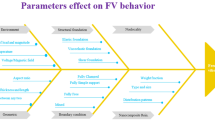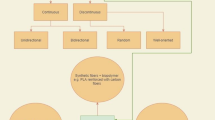Abstract
Magnetorheological elastomers (MRE) are composite materials, comprised of a viscoelastic matrix with ferromagnetic particles added to it, which enables variation in the dynamic properties through applied magnetic fields. The present work aims to experimentally identify the effects of frequency, temperature, and magnetic field on such properties. In the frequency domain, transmissibility tests of a single-degree-of-freedom system were performed, varying the applied magnetic field and temperature. An inverse optimization problem was used to fit the experimental transmissibility curves with an analytical model for the MRE. Thus, it was possible to obtain the parameters of the material that best describe the experimental data. Experimental results showed that MRE significantly increases the system stiffness, especially at higher temperatures. The comparison between experimental and analytical curves validated the mathematical model with R2 values above 0.96. A component of variation analysis showed that a variation in temperature has the most relevant effect on the MRE dynamic properties.















Similar content being viewed by others
References
Jolly MR, Carlson JD, Muñoz BC, Bullions TA (1996) The magnetoviscoelastic response of elastomer composites consisting of ferrous particles embedded in a polymer matrix. J Intell Mater Syst Struct 7:613–622. https://doi.org/10.1177/1045389X9600700601
Li Y, Li J, Li W, Du H (2014) A state-of-the-art review on magnetorheological elastomer devices. Smart Mater Struct 23:123001. https://doi.org/10.1088/0964-1726/23/12/123001
Kallio M (2005) The elastic and damping properties of magnetorheological elastomers. Tampere University of Technology, Tampere
Rabinow J (1948) The magnetic fluid clutch. Trans Am Inst Electr Eng 67:1308–1315. https://doi.org/10.1109/T-AIEE.1948.5059821
Chen L, Gong XL, Li WH (2008) Effect of carbon black on the mechanical performances of magnetorheological elastomers. Polym Test 27:340–345. https://doi.org/10.1016/j.polymertesting.2007.12.003
Nayak B, Dwivedy SK, Murthy KSRK (2015) Fabrication and characterization of magnetorheological elastomer with carbon black. J Intell Mater Syst Struct 26:830–839. https://doi.org/10.1177/1045389X14535011
Li R, Sun LZ (2014) Dynamic viscoelastic behavior of multiwalled carbon nanotube-reinforced magnetorheological (MR) nanocomposites. J Nanomech Micromech 4:A4013014. https://doi.org/10.1061/(ASCE)NM.2153-5477.0000065
Khimi SR, Pickering KL, Mace BR (2015) Dynamic properties of magnetorheological elastomers based on iron sand and natural rubber. J Appl Polym Sci 132:5–10. https://doi.org/10.1002/app.41506
Dutt JK, Nakra BC (1992) Stability of rotor systems with viscoelastic supports. J Sound Vib 153:89–96. https://doi.org/10.1016/0022-460X(92)90629-C
de Espíndola JJ, Bavastri CA, Lopes EMO (2008) Design of optimum systems of viscoelastic vibration absorbers for a given material based on the fractional calculus model. J Vib Control 14:1607–1630. https://doi.org/10.1177/1077546308087400
Ribeiro EA, Pereira JT, Bavastri CA (2015) Passive vibration control in rotor dynamics: optimization of composed support using viscoelastic materials. J Sound Vib 351:43–56. https://doi.org/10.1016/j.jsv.2015.04.007
Bronkhorst KB, Febbo M, Lopes EMO, Bavastri CA (2018) Experimental implementation of an optimum viscoelastic vibration absorber for cubic nonlinear systems. Eng Struct 163:323–331. https://doi.org/10.1016/j.engstruct.2018.02.074
Ginder JM, Schlotter WF, Nichols ME (2001) Magnetorheological elastomers in tunable vibration absorbers. Smart Struct Mater Damp Isol 4331:103–110. https://doi.org/10.1117/12.432694
Kallio M, Lindroos T, Aalto S et al (2007) Dynamic compression testing of a tunable spring element consisting of a magnetorheological elastomer. Smart Mater Struct 16:506–514. https://doi.org/10.1088/0964-1726/16/2/032
Deng HX, Gong XL (2007) Adaptive tuned vibration absorber based on magnetorheological elastomer. J Intell Mater Syst Struct 18:1205–1210. https://doi.org/10.1177/1045389X07083128
Ni ZCC, Gong XLL, Li JFF, Chen L (2009) Study on a dynamic stiffness-tuning absorber with squeeze-strain enhanced magnetorheological elastomer. J Intell Mater Syst Struct 20:1195–1202. https://doi.org/10.1177/1045389X09104790
Sinko R, Karnes M, Koo JH et al (2013) Design and test of an adaptive vibration absorber based on magnetorheological elastomers and a hybrid electromagnet. J Intell Mater Syst Struct 24:803–812. https://doi.org/10.1177/1045389X12463461
Gu X, Yu Y, Li J, Li Y (2017) Semi-active control of magnetorheological elastomer base isolation system utilising learning-based inverse model. J Sound Vib 406:346–362. https://doi.org/10.1016/j.jsv.2017.06.023
Kumbhar SB, Chavan SP, Gawade SS (2018) Adaptive tuned vibration absorber based on magnetorheological elastomer-shape memory alloy composite. Mech Syst Signal Process 100:208–223. https://doi.org/10.1016/j.ymssp.2017.07.027
Hoang N, Zhang N, Du H (2011) An adaptive tunable vibration absorber using a new magnetorheological elastomer for vehicular powertrain transient vibration reduction. Smart Mater Struct 20:015019. https://doi.org/10.1088/0964-1726/20/1/015019
Hoang N, Zhang N, Li WH, Du H (2013) Development of a torsional dynamic absorber using a magnetorheological elastomer for vibration reduction of a powertrain test rig. J Intell Mater Syst Struct 24:2036–2044. https://doi.org/10.1177/1045389X13489361
Gross B (1947) On creep and relaxation. II. J Appl Phys 19:212–221. https://doi.org/10.1063/1.1715055
Caputo M (1967) Linear models of dissipation whose Q is almost frequency independent. Geophys J Int 13:529–539. https://doi.org/10.1111/j.1365-246X.1967.tb02303.x
Caputo M, Mainardi F (1971) Linear models of dissipation in anelastic solids. La Riv Nuovo Cim 1:161–198. https://doi.org/10.1007/BF02820620
Ferry JD (1980) Viscoelastic properties of polymers, 3rd edn. Wiley, New York
Nashif AD, Jones DIG, Henderson JP (1985) Vibration damping, 1st edn. Wiley-Interscience, New York
Jones DIG (2001) Handbook of viscoelastic vibration damping, 1st edn. Wiley, Chichester
Guo F, Du C, Li R (2014) Viscoelastic parameter model of magnetorheological elastomers based on abel dashpot. Adv Mech Eng 6:629386. https://doi.org/10.1155/2014/629386
Wan Y, Xiong Y, Zhang S (2018) Temperature dependent dynamic mechanical properties of magnetorheological elastomers: experiment and modeling. Compos Struct 202:768–773. https://doi.org/10.1016/j.compstruct.2018.04.010
Norouzi M, Sajjadi Alehashem SM, Vatandoost H et al (2016) A new approach for modeling of magnetorheological elastomers. J Intell Mater Syst Struct 27:1121–1135. https://doi.org/10.1177/1045389X15615966
Vatandoost H, Norouzi M, Alehashem SMS, Smoukov SK (2017) A novel phenomenological model for dynamic behavior of magnetorheological elastomers in tension–compression mode. Smart Mater Struct 26:065011. https://doi.org/10.1088/1361-665X/aa6126
ASTM Standard (2005) E756 − 05 (Reapproved 2017)—Standard test method for measuring vibration-damping properties of materials
ASTM Standard (2011) D 5992 – 96—Standard guide for dynamic testing of vulcanized rubber and rubber-like materials using vibratory methods
Lopes EM de O, Bavastri CA, Silva Neto JM da, Espíndola JJ de (2004) caracterização dinâmica integrada de elastômeros por derivadas generalizadas. In: III Congresso nacional de engenharia mecânica—CONEM. p 13
de Espíndola JJ, da Silva Neto JM, Lopes EMO (2005) A generalised fractional derivative approach to viscoelastic material properties measurement. Appl Math Comput 164:493–506. https://doi.org/10.1016/j.amc.2004.06.099
de Medeiros Júnior WB, Préve CT, Balbino FO et al (2019) On an integrated dynamic characterization of viscoelastic materials by fractional derivative and GHM models. Lat Am J Solids Struct 16:1–19. https://doi.org/10.1590/1679-78254983
Gong XL, Zhang XZ, Zhang PQ (2005) Study of mechanical behavior and microstructure of magnetorheological elastomers. Int J Mod Phys B 19:1304–1310. https://doi.org/10.1142/S0217979205030220
Hashi HA, Muthalif AGA, Diyana Nordin NH (2016) Dynamic tuning of torsional transmissibility using magnetorheological elastomer: modelling and experimental verification. Iran J Sci Technol Trans Mech Eng 40:181–187. https://doi.org/10.1007/s40997-016-0024-6
Spasojević D, Irvine TF, Afgan N (1974) The effect of a magnetic field on the rheodynamic behavior of ferromagnetic suspensions. Int J Multiph Flow 1:607–622. https://doi.org/10.1016/0301-9322(74)90021-4
Davis LC (1999) Model of magnetorheological elastomers. J Appl Phys 85:3348–3351. https://doi.org/10.1063/1.369682
Agirre-Olabide I, Elejabarrieta M, Lion A (2015) Fractional derivative model for magnetorheological elastomers. In: Constitutive models for rubbers IX. CRC Press, pp 639–645
Agirre-Olabide I, Kuzhir P, Elejabarrieta MJ (2018) Linear magneto-viscoelastic model based on magnetic permeability components for anisotropic magnetorheological elastomers. J Magn Magn Mater 446:155–161. https://doi.org/10.1016/j.jmmm.2017.09.017
Chooi WW, Oyadiji SO (2005) Characterizing the effect of temperature and magnetic field strengths on the complex shear modulus properties of magnetorheological (MR) fluids. Int J Mod Phys B 19:1318–1324. https://doi.org/10.1142/S0217979205030244
Bagley RL, Torvik PJ (1986) On the fractional calculus model of viscoelastic behavior. J Rheol (N Y) 30:133–155. https://doi.org/10.1122/1.549887
Pritz T (1996) Analysis of four-parameter fractional derivative model of real solid materials. J Sound Vib 195:103–115. https://doi.org/10.1006/jsvi.1996.0406
Bagley RL, Torvik PJ (1983) A theoretical basis for the application of fractional calculus to viscoelasticity. J Rheol (N Y) 27:201. https://doi.org/10.1122/1.549724
Alfrey T (1944) Non-homogeneous stresses in visco-elastic media. Q Appl Math 2:113–119. https://doi.org/10.1090/qam/10499
Schwarzl F, Staverman AJ (1952) Time-temperature dependence of linear viscoelastic behavior. J Appl Phys 23:838–843. https://doi.org/10.1063/1.1702316
Olienick Filho EG, Lopes EMO, Bavastri CA (2019) Integrated dynamic characterization of thermorheologically simple viscoelastic materials accounting for frequency, temperature, and preload effects. Materials (Basel) 12:1962. https://doi.org/10.3390/ma12121962
Williams ML, Landel RF, Ferry JD (1955) The temperature dependence of relaxation mechanisms in amorphous polymers and other glass-forming liquids. J Am Chem Soc 77:3701–3707. https://doi.org/10.1021/ja01619a008
Shen Y, Golnaraghi MF, Heppler GR (2004) Experimental research and modeling of magnetorheological elastomers. J Intell Mater Syst Struct 15:27–35. https://doi.org/10.1177/1045389X04039264
Rosensweig RE (1985) Ferrohydrodynamics, 1st edn. Cambridge University Press, Cambridge
Furst EM, Gast AP (2000) Micromechanics of magnetorheological suspensions. Phys Rev E Stat Phys Plasmas Fluids Relat Interdiscip Top 61:6732–6739. https://doi.org/10.1103/PhysRevE.61.6732
Deng H, Gong X, Wang L (2006) Development of an adaptive tuned vibration absorber with magnetorheological elastomer. Smart Mater Struct 15:N111–N116. https://doi.org/10.1088/0964-1726/15/5/N02
Inman DJ (2014) Engineering vibration, 4th edn. Pearson, New Jersey
Storn R, Price K (1997) Differential evolution—a simple and efficient heuristic for global optimization over continuous spaces. J Glob Optim 11:341–359. https://doi.org/10.1023/A:1008202821328
Mandal D, Chatterjee A, Bhattacharjee AK (2013) Design of fully digital controlled shaped beam synthesis using differential evolution algorithm. Int J Antennas Propag 2013:1–9. https://doi.org/10.1155/2013/713680
Price K, Storn R, Lampinen JA (2005) differential evolution: a practical approach to global optimization. Springer, Berlin/Heidelberg
Onwubolu GC, Babu BV (2004) New optimization techniques in engineering. Springer, Berlin Heidelberg
Zaharie D (2002) Critical values for the control parameters of differential evolution algorithms. In: Proceedings of MENDEL 2002—8th international conference on soft computing. Brno, Czech Republic, pp 62–67
Storn R (2002) On the usage of differential evolution for function optimization. In: Proceedings of North American fuzzy information processing. IEEE, pp 519–523
Gämperle R, Müller SD, Koumoutsakos P (2002) A parameter study for differential evolution. In: WSEAS—international conference on advances in intelligent systems, fuzzy systems, evolutionary computation. pp 293–298
Venter GS, Beck AT, da Silva MM (2016) A simple hierarchical procedure for parameter identification in robust topology optimization. J Braz Soc Mech Sci Eng 38:679–689. https://doi.org/10.1007/s40430-014-0271-7
Prajapati DR, Mahapatra PB (2007) An effective joint X-bar and R chart to monitor the process mean and variance. Int J Prod Qual Manag 2:459–471. https://doi.org/10.1504/IJPQM.2007.013339
Schenck JF (1996) The role of magnetic susceptibility in magnetic resonance imaging: MRI magnetic compatibility of the first and second kinds. Med Phys 23:815–850. https://doi.org/10.1118/1.597854
Abramchuk S, Kramarenko E, Stepanov G et al (2007) Novel highly elastic magnetic materials for dampers and seals: Part I. Preparation and characterization of the elastic materials. Polym Adv Technol 18:883–890. https://doi.org/10.1002/pat.924
Sorokin VV, Ecker E, Stepanov GV et al (2014) Experimental study of the magnetic field enhanced Payne effect in magnetorheological elastomers. Soft Matter 10:8765–8776. https://doi.org/10.1039/C4SM01738B
Ubaidillah SJ, Purwanto A, Mazlan SA (2015) Recent progress on magnetorheological solids: materials, fabrication, testing, and applications. Adv Eng Mater 17:563–597. https://doi.org/10.1002/adem.201400258
Anderson-Sprecher R (1994) Model comparisons and R2. Am Stat 48:113. https://doi.org/10.2307/2684259
Acknowledgements
Thiago Silva acknowledges the financial support from CAPES. Carlos Alberto Bavastri acknowledges the financial support from CNPq.
Author information
Authors and Affiliations
Corresponding author
Ethics declarations
Conflict of interests
The author(s) declared no potential conflict of interest regarding research, authorship, and/or publication of this article.
Additional information
Technical Editor: Pedro Manuel Calas Lopes Pacheco, D.Sc.
Publisher's Note
Springer Nature remains neutral with regard to jurisdictional claims in published maps and institutional affiliations.
Rights and permissions
About this article
Cite this article
da Silva, T., Venter, G.S. & Bavastri, C.A. Magnetorheological elastomer dynamic characterization method considering temperature, frequency, and magnetic field. J Braz. Soc. Mech. Sci. Eng. 43, 70 (2021). https://doi.org/10.1007/s40430-021-02821-z
Received:
Accepted:
Published:
DOI: https://doi.org/10.1007/s40430-021-02821-z




